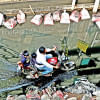It’s time to turn down the heat

It is hardly a surprise that the hottest April in recent history has felt even hotter in Dhaka, thanks to rampant and unplanned urbanisation that has turned a once lush and riverine city into a heat chamber. A recent study has highlighted what Dhaka inhabitants have been experiencing for a while now: a staggering 6°C rise in temperature within the city due to the urban heat island (UHI) effect. As green spaces and wetlands have been ruthlessly occupied in the name of development, our cities have become significantly hotter than surrounding rural areas. Alarmingly, as much as 75 percent of the city is now covered with asphalt and concrete structures, which trap heat instead of allowing it to dissipate naturally. As a result, Dhaka residents face not only discomfort, but also potential health risks, particularly children, the elderly and low-income communities living in cramped slums or working outdoors.
The climate crisis isn't a distant problem—and it isn't just affecting the coastal belts. The latest heatwave has confirmed that the climate crisis is, indeed, unfolding within our very streets, and it's high time our policymakers understood that the irresponsible way in which our cities are being ravaged will only aggravate the impacts of climate change. While a city should have at least 15 percent green spaces and 10-12 percent wetland, a study conducted by the Bangladesh Institute of Planners (BIP) found that in the last 28 years, green space in Central Dhaka has shrunk to 7.09 percent while wetlands occupy only 2.9 percent of the city. It is simply not sustainable for us to continue down the same reckless trajectory in the days to come.
Bangladesh, which professes to be a climate champion in the global arena, must seriously confront how its narrow vision of growth and development is contributing to the climate crisis locally. Promises of tree planting by city mayors will not bear any real fruit; what we need is a serious reevaluation and reorientation of our current vision. City planners, policymakers and climate change experts need to collectively re-envision what climate-resilient cities look like, and take active steps to reverse the destructive path we are currently treading.


 For all latest news, follow The Daily Star's Google News channel.
For all latest news, follow The Daily Star's Google News channel. 







Comments